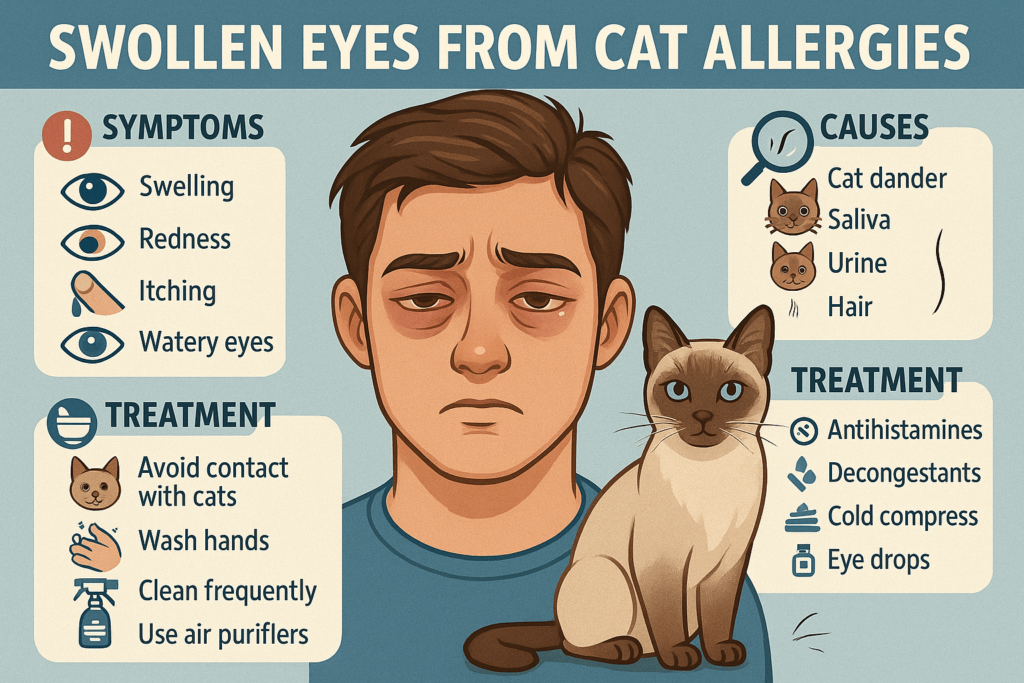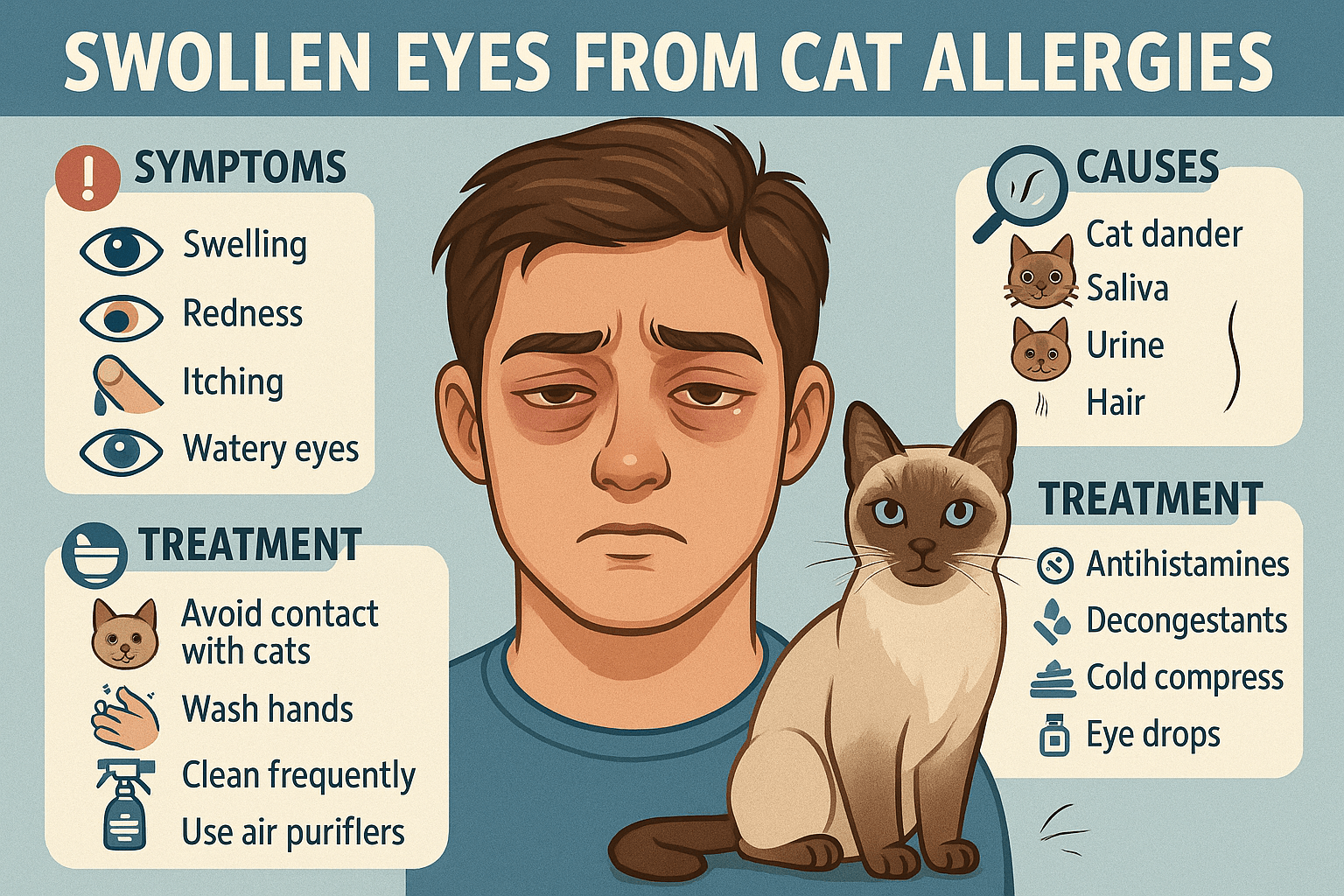Swollen Eyes from Cat Allergies: What You Need to Know
For many people, the joy of being around cats is overshadowed by the discomfort of cat allergies. One of the most common symptoms is swollen eyes, which can range from mildly irritating to severely uncomfortable. These reactions are triggered by proteins found in a cat’s dander, saliva, and even urine. While some individuals experience mild sneezing or itching, others may develop more pronounced symptoms like redness, puffiness, or watery eyes. Understanding the causes and treatment options for swollen eyes due to cat allergies can help you manage this condition effectively. Let’s explore everything you need to know about identifying, preventing, and alleviating these allergic reactions.
Expert Insight on Cat Allergies
“This happens when your cat’s immune system identifies a foreign substance as a threat and responds by releasing inflammatory chemicals, such as prostaglandin, cytokines, heparin, and histamine, leading to symptoms like redness, swelling, or itching.”
Common Symptoms of Cat Allergies Leading to Swollen Eyes
Swollen eyes are often just one part of a broader set of allergic reactions caused by exposure to cats. Recognizing these symptoms early can help you take action before they worsen.
Redness Around the Eyes:
The area surrounding the eyes may appear inflamed and irritated, signaling an allergic response.Itchy or Watery Eyes:
Constant itching or excessive tearing is a typical reaction as the body tries to flush out allergens.Puffiness and Swelling:
The eyelids or areas under the eyes may become noticeably swollen, making it uncomfortable to blink or open your eyes fully.Sneezing and Nasal Congestion:
Allergic reactions often include respiratory symptoms, which can exacerbate eye irritation.Dark Circles Under the Eyes:
Known as “allergic shiners,” these dark circles result from increased blood flow to the sinuses during an allergic reaction.
Identifying these symptoms early allows you to address the root cause and find relief before the swelling becomes severe.

Tips for Managing Swollen Eyes Caused by Cat Allergies
If you’re dealing with swollen eyes due to cat allergies, there are practical steps you can take to alleviate discomfort and reduce exposure to allergens.
Use Over-the-Counter Antihistamines:
Medications like cetirizine or loratadine can help reduce swelling and other allergy symptoms.Apply Cold Compresses:
A cold, damp cloth placed over the eyes can reduce puffiness and soothe irritation.Wash Your Hands Frequently:
After touching a cat, wash your hands thoroughly to prevent transferring allergens to your face.Keep Cats Out of Bedrooms:
Designating certain areas as pet-free zones minimizes allergen exposure where you rest or sleep.Invest in an Air Purifier:
High-efficiency particulate air (HEPA) purifiers trap allergens, improving indoor air quality.
By incorporating these strategies into your routine, you can minimize the impact of cat allergies on your eyes and overall well-being.
Check this guide 👉Cat Allergy Diet: Best 7 Expert Tips!
Check this guide 👉Benadryl for Cat Allergy: Best 7 Expert Tips!
Check this guide 👉Cat Allergic to Salmon: Best 7 Health Tips!
Prevention Strategies for Cat Allergies | Immediate Relief Options |
|---|---|
Bathe your cat regularly | Use antihistamine eye drops |
Vacuum frequently with a HEPA filter | Apply a cold compress to swollen eyes |
Wash bedding in hot water weekly | Avoid rubbing or scratching irritated eyes |
Wear a mask while cleaning | Stay hydrated to reduce eye dryness |
Limit close contact with cats | Rinse eyes with saline solution |
Understanding the Causes of Swollen Eyes from Cat Allergies
To effectively manage swollen eyes caused by cat allergies, it’s important to understand what triggers these reactions. Identifying the source of allergens can help you take targeted steps to reduce exposure.
Proteins in Cat Dander:
Tiny flakes of dead skin shed by cats contain the protein Fel d 1, a major allergen responsible for most reactions.Saliva and Grooming Habits:
Cats spread allergenic proteins onto their fur through grooming, which then becomes airborne or sticks to surfaces.Urine and Feces:
Allergens are also present in a cat’s waste, though less commonly associated with eye symptoms.Airborne Particles:
Lightweight allergens can linger in the air for hours, increasing the likelihood of inhalation or contact with sensitive areas like the eyes.Individual Sensitivity Levels:
Some people have heightened sensitivity to cat allergens, leading to more pronounced reactions such as swollen eyes.
Understanding these causes empowers you to create a safer environment and minimize allergic flare-ups.
When to Seek Medical Attention for Swollen Eyes
While most cases of swollen eyes from cat allergies can be managed at home, certain situations require professional medical attention. Knowing when to consult a doctor ensures your health isn’t compromised.
Severe Swelling That Doesn’t Subside:
If swelling persists despite home remedies, it could indicate a more serious allergic reaction.Difficulty Breathing or Swallowing:
These symptoms may signal anaphylaxis, a life-threatening condition requiring immediate care.Infection Signs Around the Eyes:
Redness, warmth, or discharge from the eyes could indicate an infection that needs antibiotic treatment.Vision Changes or Blurred Sight:
Any alteration in vision should be evaluated promptly by an eye specialist.Chronic or Persistent Symptoms:
If your symptoms recur frequently or worsen over time, it’s wise to consult an allergist for long-term solutions.
Seeking timely medical advice prevents complications and ensures proper diagnosis and treatment.
Tips for Minimizing Allergens in Your Home
Reducing allergens in your living space is key to managing cat allergies effectively. Here are some practical tips to keep your home cleaner and healthier.
Bathe Your Cat Weekly:
Regular baths can remove allergens from your cat’s coat, though not all cats tolerate this well.Dust Surfaces Frequently:
Use a damp cloth to trap allergens instead of spreading them around.Wash Fabrics Often:
Clean curtains, rugs, and upholstery regularly to remove accumulated dander.Restrict Pets to Certain Rooms:
Limiting your cat’s access to specific areas reduces allergen spread throughout the house.Replace Carpets with Hard Flooring:
Hard surfaces are easier to clean and less likely to harbor allergens.
Implementing these strategies creates a cleaner, more allergen-free environment for everyone.
Alternative Solutions for Coping with Cat Allergies
If traditional methods aren’t enough, alternative approaches can complement your efforts to manage cat allergies.
Natural Supplements:
Omega-3 fatty acids and quercetin supplements may help reduce inflammation and support immune health.Essential Oils (Used Safely):
Eucalyptus or tea tree oil diffusers can purify the air, though they must be used cautiously around pets.Probiotics:
Supporting gut health with probiotics may enhance your body’s ability to handle allergens.Steam Treatments:
Inhaling steam can relieve nasal congestion and ease eye irritation caused by allergies.Allergy-Proof Bedding Covers:
Encasing mattresses and pillows in allergen-proof covers prevents allergens from settling in your bed.
Exploring these alternatives offers additional ways to combat cat allergies and improve daily comfort.
How to Create an Allergy-Friendly Environment
Transforming your home into an allergy-friendly space involves thoughtful planning and consistent habits. Here’s how to get started.
Declutter Your Space:
Fewer items mean fewer surfaces for allergens to settle on, making cleaning easier.Choose Low-Pile Rugs:
Thick carpets trap allergens; opting for low-pile or washable rugs helps minimize buildup.Maintain Optimal Humidity Levels:
Keeping humidity between 30% and 50% prevents mold growth and discourages dust mites.Clean HVAC Systems Regularly:
Replace filters and clean vents to ensure allergen-free airflow throughout your home.Adopt a “Shoes Off” Policy:
Removing shoes indoors prevents tracking in outdoor allergens that could worsen symptoms.
Creating an allergy-friendly environment reduces exposure to irritants, promoting better health and peace of mind.
Frequently Asked Questions About Swollen Eyes from Cat Allergies
Can I develop cat allergies later in life?
Yes, allergies can develop at any age, even if you’ve previously had no issues with cats.
Are hypoallergenic cats truly allergy-free?
No breed is completely hypoallergenic, but some produce fewer allergens than others, potentially reducing symptoms.
How do I clean my home to reduce cat allergens?
Regular vacuuming, washing fabrics, and using HEPA filters can significantly lower allergen levels.
Will wearing glasses protect my eyes from allergens?
Glasses can provide some barrier protection, but they won’t block all airborne particles.
Is immunotherapy effective for cat allergies?
Allergy shots or sublingual tablets can desensitize your immune system over time, offering long-term relief.
Living Comfortably Despite Cat Allergies
Swollen eyes from cat allergies can be frustrating, but with the right knowledge and tools, you can enjoy the companionship of felines without compromising your comfort. By understanding the causes, implementing preventive measures, and seeking professional help when needed, you can strike a balance between managing your allergies and sharing your life with a beloved pet. Remember, small changes—like regular cleaning, investing in air purifiers, or consulting an allergist—can make a big difference. With patience and persistence, living harmoniously with cats is entirely possible, even for allergy sufferers.
Understanding Cryptosporidium in Cats: Best 7 Expert Tips! – Spot symptoms, treat safely, and stop parasite spread in your home.
Understanding Cryptosporidium in Dogs: Best 7 Expert Tips! – Learn symptoms, treatment & prevention for this stubborn gut parasite.
Understanding Syringomyelia in Cats: Best 7 Expert Tips! – Recognize signs, manage pain, and support your cat’s neurological health with vet-backed guidance.
Understanding Syringomyelia in Dogs: Best 7 Expert Tips! – Expert insights on symptoms, MRI diagnosis, pain management & quality of life.





